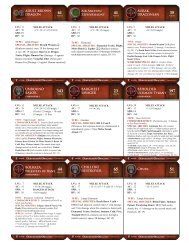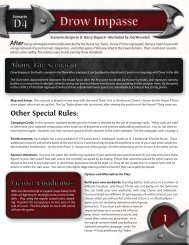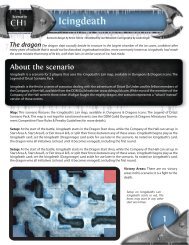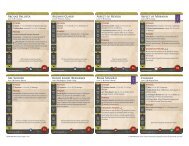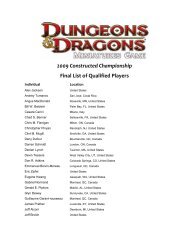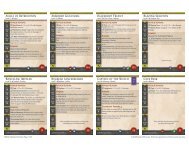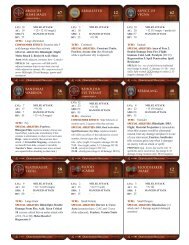Create successful ePaper yourself
Turn your PDF publications into a flip-book with our unique Google optimized e-Paper software.
For example, the Lion of Talisid can cast a flame strike spell once per battle. The spell entry on<br />
its stat card looks like this:<br />
flame strike (sight; radius 2; 30 fire damage; DC 16)<br />
Number of Uses<br />
Most spells can be cast only a limited number of times. For many creatures, this is indicated<br />
by a number of check boxes () after the spell’s name, one for each time the spell can<br />
be cast.<br />
Some creatures instead have a selection of spells they can cast again and again, called Sorcerer<br />
Spells. (This is true even if the creature isn’t really a sorcerer.) In these cases, the stat card<br />
instead lists the spells available and a separate series of check boxes for each level of spell the<br />
creature can cast. It’s okay to use a higher-level spell’s box, if there is one available, to cast a<br />
lower-level spell.<br />
Range<br />
A spell’s range indicates how far from the caster the effect can occur. There are eight standard<br />
ranges: self, touch, range 6, cone, line 12, sight, your warband, and any warband. See the<br />
glossary for complete descriptions.<br />
Line of Sight and Area Effects: Terrain that blocks line of effect blocks area effects,<br />
including circles, cones, and lines. Only squares inside an area effect that have line of effect to<br />
the origin point of the effect are affected by the spell or ability. Though centered on a corner,<br />
the origin point of an area effect that touches a wall is considered to be on the same side of the<br />
wall as the target of the spell or ability (for effects with a radius), or the same side as the acting<br />
creature (for line and cone effects). Thus, the wall blocks line of effect to creatures on the<br />
opposite side of the wall. An area effect that originates at the end of a thin wall is not blocked<br />
by that wall.<br />
Radius<br />
Some spells affect a roughly circular area of the battle map. These spells’ entries list the radius<br />
of their effect. See the glossary for descriptions of these keywords.<br />
Effects and Conditions<br />
A few of the most common spell effects and keywords are discussed here. Others are<br />
explained in more detail in the glossary.<br />
Spell Duration: Spell effects last until the end of the battle (skirmish) unless the text of the<br />
spell or effect says otherwise.<br />
Spells That Don’t Affect Certain Creatures: Some spells don’t work against certain types or<br />
kinds of creatures. If the nearest target happens to be a creature the spell can’t affect, choose<br />
another spell or move the caster to a location where it can target the right creature type.<br />
Spells That Grant Bonuses or Penalties: Bonuses that are simple additions to a creature’s<br />
statistics use a “+” sign. For example, bear’s endurance (touch; target living creature gets +10<br />
hp) increases the target’s hit points by 10.<br />
Spell Stacking: Different spells that grant bonuses to the same statistic are usually cumulative.<br />
For example, casting magic weapon (touch; attack +1, ignore DR) and bless (your warband;<br />
attack +1) on the same creature gives that creature a +2 bonus on attacks. The same applies to<br />
spells that impose penalties or other harmful effects.<br />
Duplicate Spells: No creature can benefit from two castings of the same spell if it grants<br />
an ongoing effect; a second magic weapon spell cast on a creature does not provide any<br />
additional bonus. Likewise, duplicate harmful spells’ effects don’t stack.<br />
23



